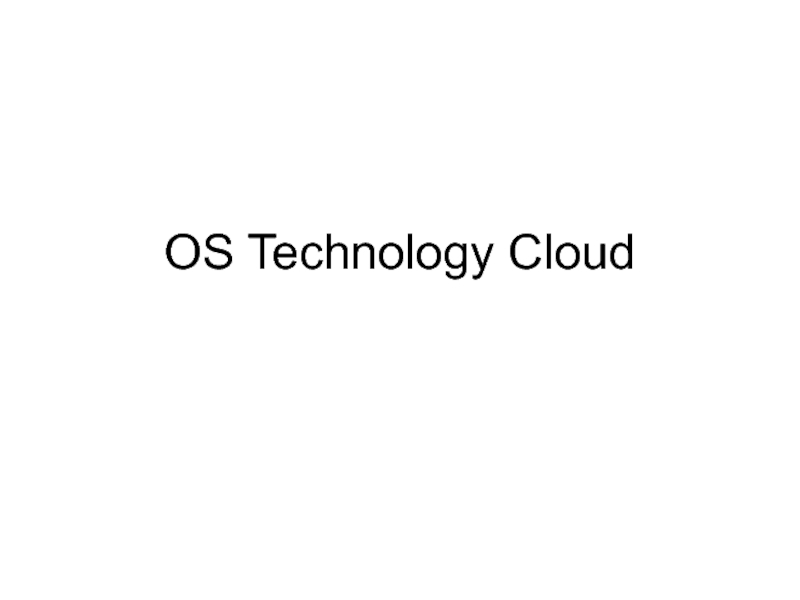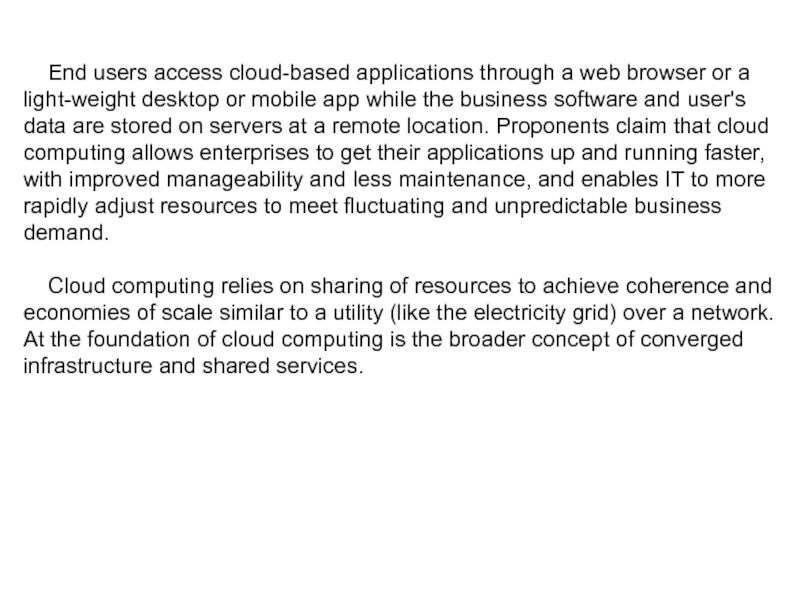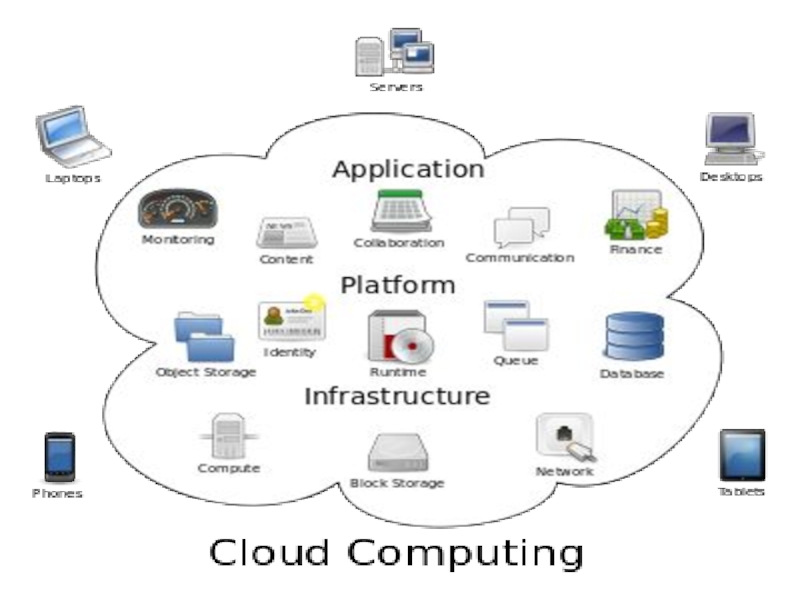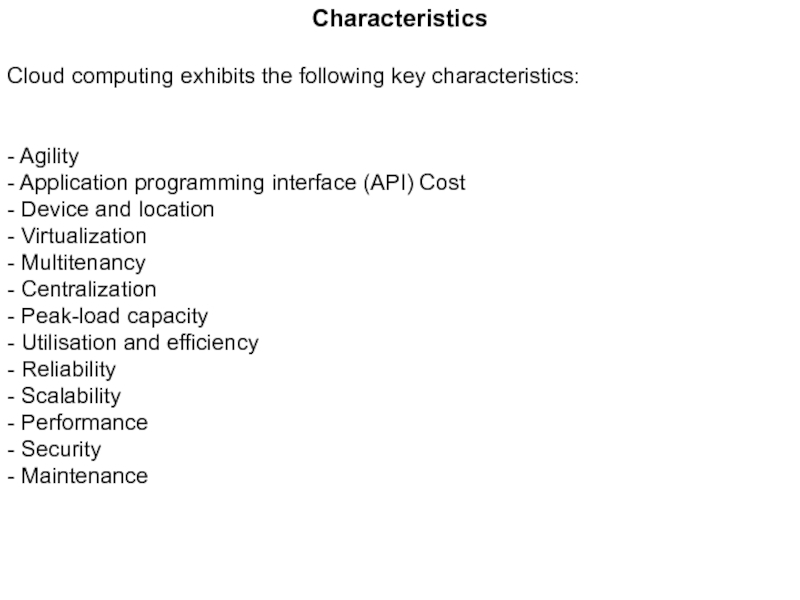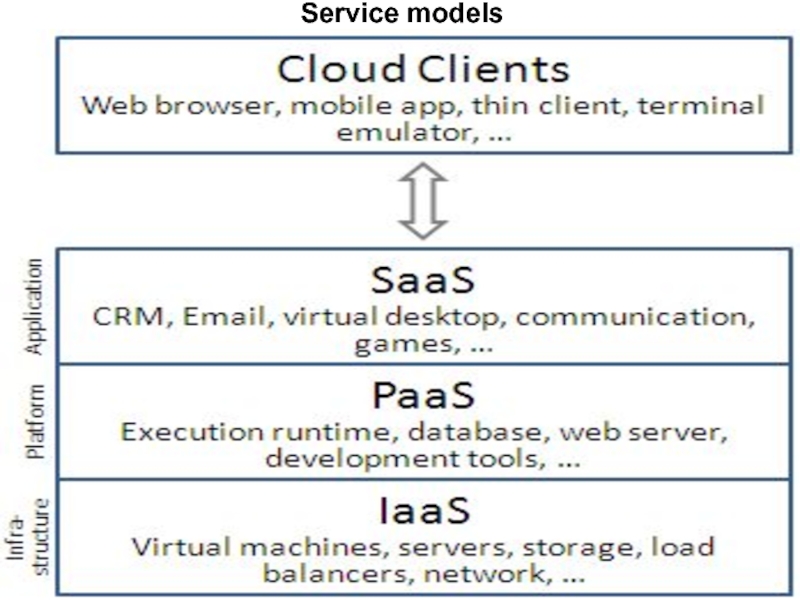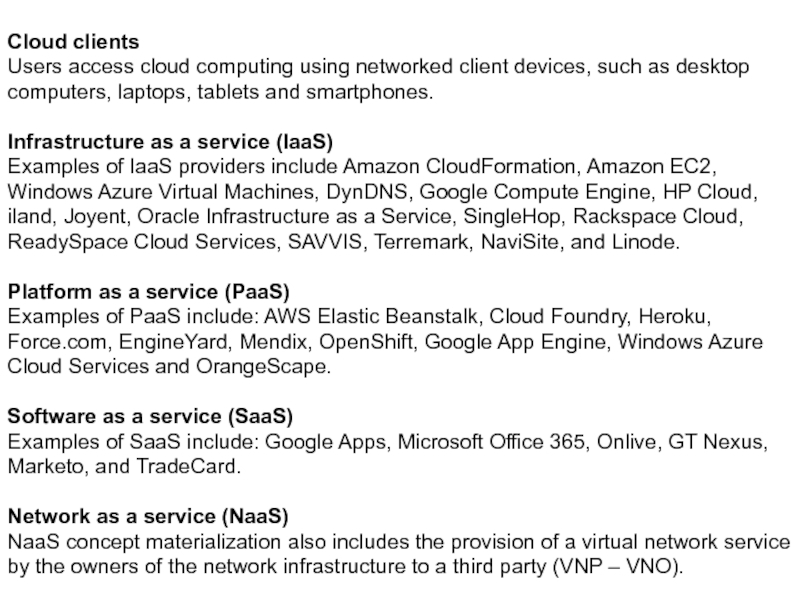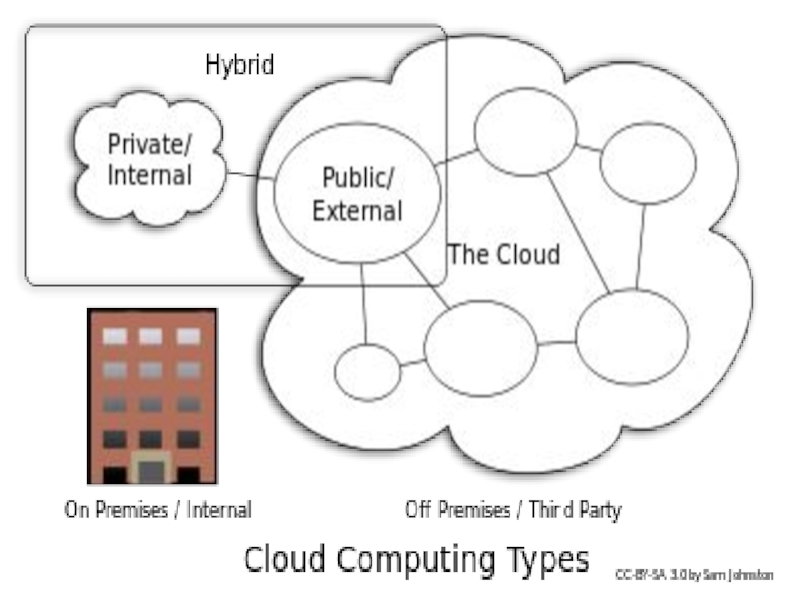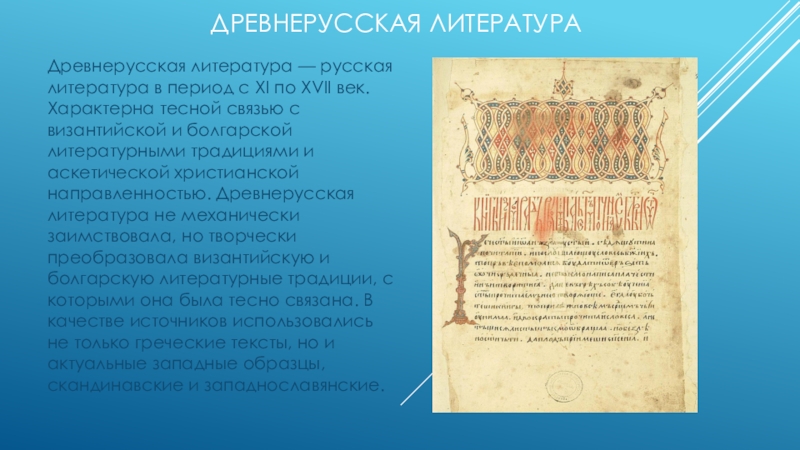Слайд 2
Cloud computing is the use of
computing resources (hardware and software) that are delivered as a
service over a network (typically the Internet). The name comes from the use of a cloud-shaped symbol as an abstraction for the complex infrastructure it contains in system diagrams. Cloud computing entrusts remote services with a user's data, software and computation.
In the business model using software as a service, users are provided access to application software and databases. Cloud providers manage the infrastructure and platforms that run the applications. SaaS is sometimes referred to as “on-demand software” and is usually priced on a pay-per-use basis. SaaS providers generally price applications using a subscription fee.
Proponents claim that the SaaS allows a business the potential to reduce IT operational costs by outsourcing hardware and software maintenance and support to the cloud provider. This enables the business to reallocate IT operations costs away from hardware/software spending and personnel expenses, towards meeting other IT goals. In addition, with applications hosted centrally, updates can be released without the need for users to install new software. One drawback of SaaS is that the users' data are stored on the cloud provider’s server. As a result, there could be unauthorized access to the data.
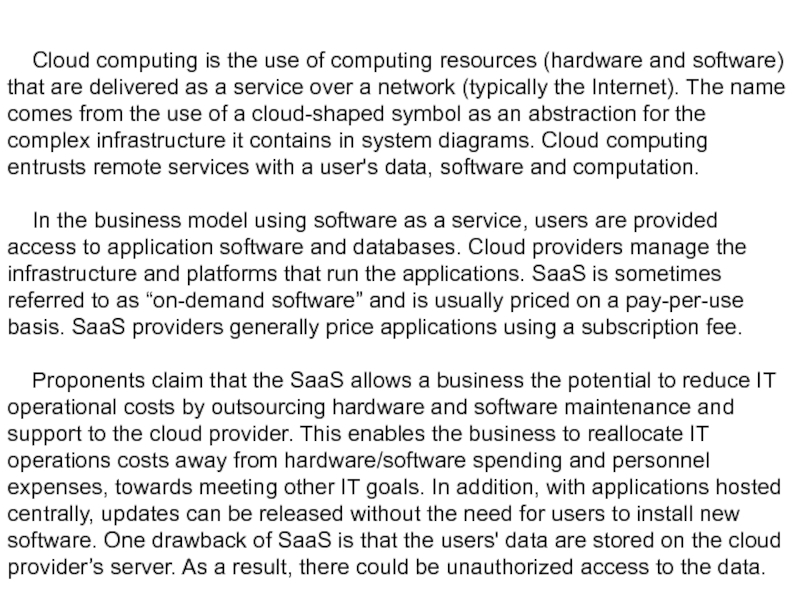
Слайд 3 End users access cloud-based applications through a web
browser or a light-weight desktop or mobile app while the
business software and user's data are stored on servers at a remote location. Proponents claim that cloud computing allows enterprises to get their applications up and running faster, with improved manageability and less maintenance, and enables IT to more rapidly adjust resources to meet fluctuating and unpredictable business demand.
Cloud computing relies on sharing of resources to achieve coherence and economies of scale similar to a utility (like the electricity grid) over a network. At the foundation of cloud computing is the broader concept of converged infrastructure and shared services.
Слайд 5Similar systems and concepts
Cloud computing shares characteristics with:
-Autonomic computing —
Computer systems capable of self-management.
-Client–server model — Client–server computing refers
broadly to any distributed application that distinguishes between service providers (servers) and service requesters (clients).
-Grid computing — "A form of distributed and parallel computing, whereby a 'super and virtual computer' is composed of a cluster of networked, loosely coupled computers acting in concert to perform very large tasks."
-Mainframe computer — Powerful computers used mainly by large organizations for critical applications, typically bulk data processing such as census, industry and consumer statistics, police and secret intelligence services, enterprise resource planning, and financial transaction processing.
-Utility computing — The "packaging of computing resources, such as computation and storage, as a metered service similar to a traditional public utility, such as electricity.“
-Peer-to-peer means distributed architecture without the need for central coordination. Participants are both suppliers and consumers of resources (in contrast to the traditional client–server model).
-Cloud gaming—also known as on-demand gaming—is a way of delivering games to computers. Gaming data is stored in the provider's server, so that gaming is independent of client computers used to play the game.
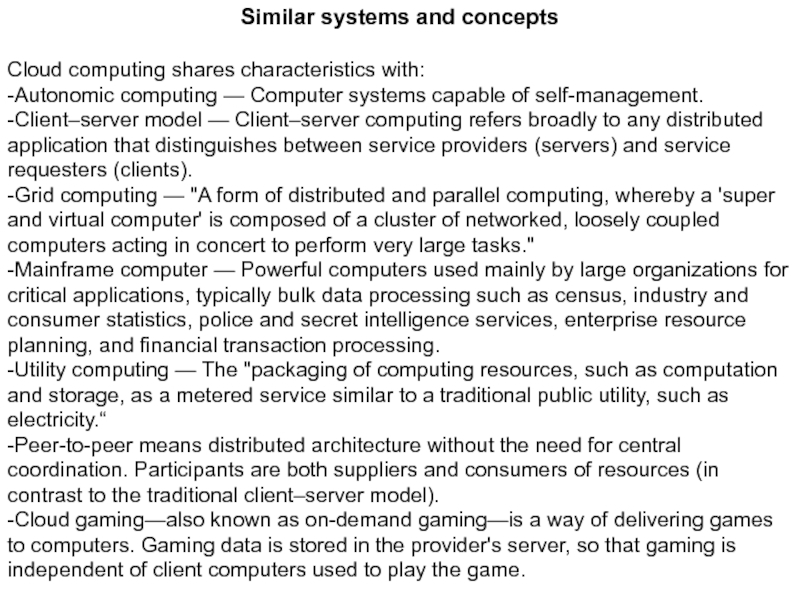
Слайд 6Characteristics
Cloud computing exhibits the following key characteristics:
- Agility
- Application
programming interface (API) Cost
- Device and location
- Virtualization
- Multitenancy
- Centralization
- Peak-load capacity
- Utilisation and efficiency
- Reliability
- Scalability
- Performance
- Security
- Maintenance
Слайд 8
Cloud clients
Users access cloud computing using networked client devices, such
as desktop computers, laptops, tablets and smartphones.
Infrastructure as a
service (IaaS)
Examples of IaaS providers include Amazon CloudFormation, Amazon EC2, Windows Azure Virtual Machines, DynDNS, Google Compute Engine, HP Cloud, iland, Joyent, Oracle Infrastructure as a Service, SingleHop, Rackspace Cloud, ReadySpace Cloud Services, SAVVIS, Terremark, NaviSite, and Linode.
Platform as a service (PaaS)
Examples of PaaS include: AWS Elastic Beanstalk, Cloud Foundry, Heroku, Force.com, EngineYard, Mendix, OpenShift, Google App Engine, Windows Azure Cloud Services and OrangeScape.
Software as a service (SaaS)
Examples of SaaS include: Google Apps, Microsoft Office 365, Onlive, GT Nexus, Marketo, and TradeCard.
Network as a service (NaaS)
NaaS concept materialization also includes the provision of a virtual network service by the owners of the network infrastructure to a third party (VNP – VNO).
Слайд 10
Public cloud applications, storage, and other resources are made available
to the general public by a service provider. These services
are free or offered on a pay-per-use model. Generally, public cloud service providers like Amazon AWS, Microsoft and Google own and operate the infrastructure and offer access only via Internet (direct connectivity is not offered)
Community cloud shares infrastructure between several organizations from a specific community with common concerns (security, compliance, jurisdiction, etc.), whether managed internally or by a third-party and hosted internally or externally. The costs are spread over fewer users than a public cloud (but more than a private cloud), so only some of the cost savings potential of cloud computing are realized
Hybrid cloud is a composition of two or more clouds (private, community or public) that remain unique entities but are bound together, offering the benefits of multiple deployment models.
Private cloud is cloud infrastructure operated solely for a single organization, whether managed internally or by a third-party and hosted internally or externally. Undertaking a private cloud project requires a significant level and degree of engagement to virtualize the business environment, and requires the organization to reevaluate decisions about existing resources. When done right, it can have improve business, but every step in the project raises security issues that must be addressed to prevent serious vulnerabilities.
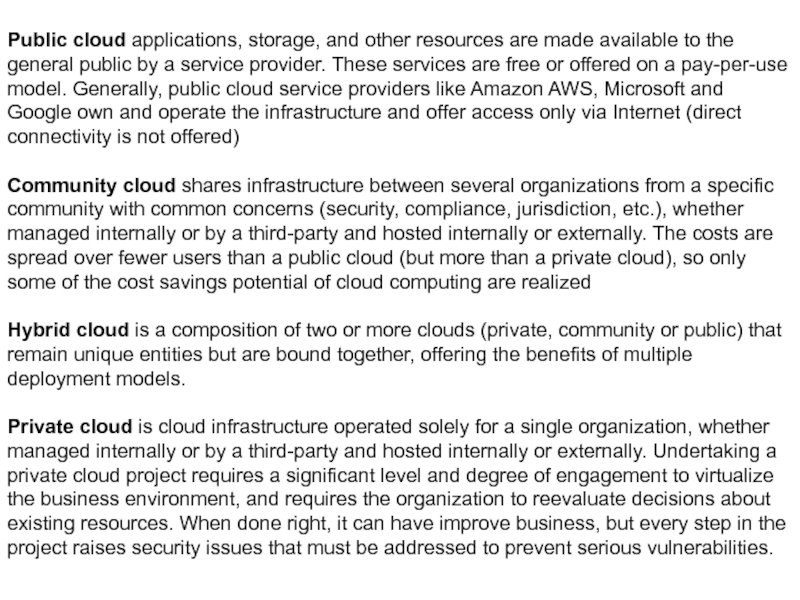
Слайд 11THANKS FOR YOUR ATTENTION!
QUESTIONS
???
